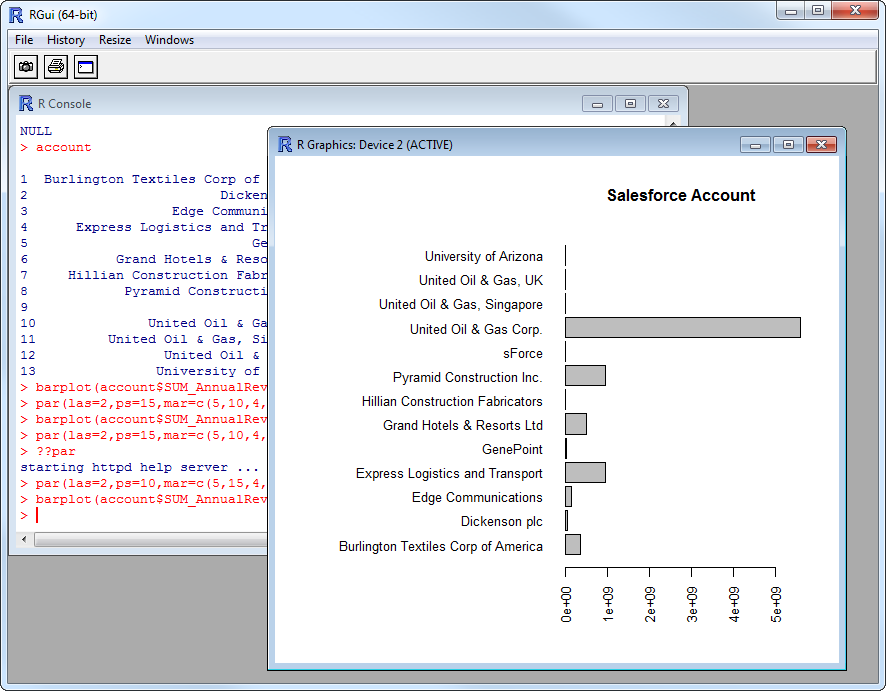Discover how a bimodal integration strategy can address the major data management challenges facing your organization today.
Get the Report →Analyze SAS xpt Data in R
Use standard R functions and the development environment of your choice to analyze SAS xpt data with the CData JDBC Driver for SAS xpt.
Access SAS xpt data with pure R script and standard SQL on any machine where R and Java can be installed. You can use the CData JDBC Driver for SAS xpt and the RJDBC package to work with remote SAS xpt data in R. By using the CData Driver, you are leveraging a driver written for industry-proven standards to access your data in the popular, open-source R language. This article shows how to use the driver to execute SQL queries to SAS xpt and visualize SAS xpt data by calling standard R functions.
Install R
You can match the driver's performance gains from multi-threading and managed code by running the multithreaded Microsoft R Open or by running open R linked with the BLAS/LAPACK libraries. This article uses Microsoft R Open 3.2.3, which is preconfigured to install packages from the Jan. 1, 2016 snapshot of the CRAN repository. This snapshot ensures reproducibility.
Load the RJDBC Package
To use the driver, download the RJDBC package. After installing the RJDBC package, the following line loads the package:
library(RJDBC)
Connect to SAS xpt as a JDBC Data Source
You will need the following information to connect to SAS xpt as a JDBC data source:
- Driver Class: Set this to cdata.jdbc.sasxpt.SASXptDriver
- Classpath: Set this to the location of the driver JAR. By default this is the lib subfolder of the installation folder.
The DBI functions, such as dbConnect and dbSendQuery, provide a unified interface for writing data access code in R. Use the following line to initialize a DBI driver that can make JDBC requests to the CData JDBC Driver for SAS xpt:
driver <- JDBC(driverClass = "cdata.jdbc.sasxpt.SASXptDriver", classPath = "MyInstallationDir\lib\cdata.jdbc.sasxpt.jar", identifier.quote = "'")
You can now use DBI functions to connect to SAS xpt and execute SQL queries. Initialize the JDBC connection with the dbConnect function.
Connecting to Local SASXpt Files
You can connect to local SASXpt file by setting the URI to a folder containing SASXpt files.
Connecting to S3 data source
You can connect to Amazon S3 source to read SASXpt files. Set the following properties to connect:
- URI: Set this to the folder within your bucket that you would like to connect to.
- AWSAccessKey: Set this to your AWS account access key.
- AWSSecretKey: Set this to your AWS account secret key.
- TemporaryLocalFolder: Set this to the path, or URI, to the folder that is used to temporarily download SASXpt file(s).
Connecting to Azure Data Lake Storage Gen2
You can connect to ADLS Gen2 to read SASXpt files. Set the following properties to connect:
- URI: Set this to the name of the file system and the name of the folder which contacts your SASXpt files.
- AzureAccount: Set this to the name of the Azure Data Lake storage account.
- AzureAccessKey: Set this to our Azure DataLakeStore Gen 2 storage account access key.
- TemporaryLocalFolder: Set this to the path, or URI, to the folder that is used to temporarily download SASXpt file(s).
Built-in Connection String Designer
For assistance in constructing the JDBC URL, use the connection string designer built into the SAS xpt JDBC Driver. Either double-click the JAR file or execute the jar file from the command-line.
java -jar cdata.jdbc.sasxpt.jar
Fill in the connection properties and copy the connection string to the clipboard.

Below is a sample dbConnect call, including a typical JDBC connection string:
conn <- dbConnect(driver,"jdbc:sasxpt:URI=C:/folder;")
Schema Discovery
The driver models SAS xpt APIs as relational tables, views, and stored procedures. Use the following line to retrieve the list of tables:
dbListTables(conn)
Execute SQL Queries
You can use the dbGetQuery function to execute any SQL query supported by the SAS xpt API:
sampletable_1 <- dbGetQuery(conn,"SELECT Id, Column1 FROM SampleTable_1 WHERE Column2 = '100'")
You can view the results in a data viewer window with the following command:
View(sampletable_1)
Plot SAS xpt Data
You can now analyze SAS xpt data with any of the data visualization packages available in the CRAN repository. You can create simple bar plots with the built-in bar plot function:
par(las=2,ps=10,mar=c(5,15,4,2))
barplot(sampletable_1$Column1, main="SAS xpt SampleTable_1", names.arg = sampletable_1$Id, horiz=TRUE)







